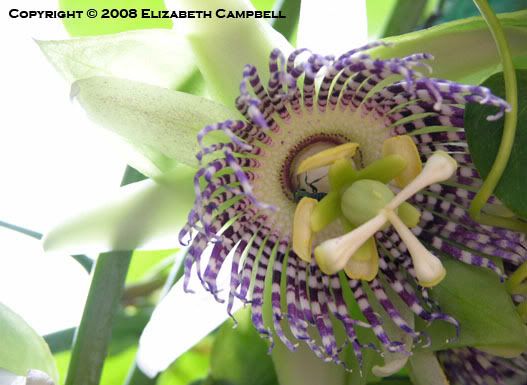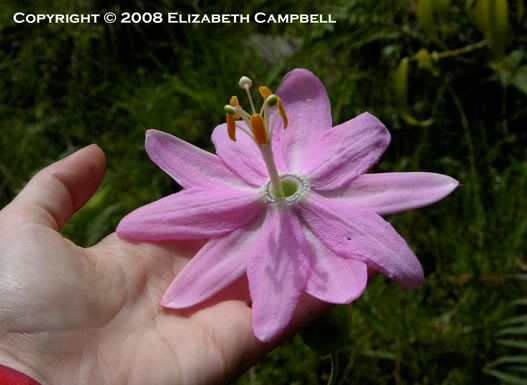
 |
Re: passion flower / fruit
Beth, is there any concern with the neurological effects of annonacin there? There's a much higher rate among some groups of people that eat soursop and make tea from its leaves, but cherimoya and pawpaw also contain the chemical.
|
Re: passion flower / fruit
Quote:
Is that what makes her so...you know what I mean..? |
Re: passion flower / fruit
If they're really going to be red, they're most likely P. manicata
Harvey, to feel any detrimental effects of Annonaicin I'd have to be eating 5 Chirimoyas a day, plus two Guayabanas, and drinking the tea. At the rate at which most people here consume Chirimoya and Guayabana (ie on occasion, one fruit at a sitting) there is absolutely no danger. The islanders who went crazy ate it every day, and ate the leaves, and used the crushed seeds as medicine. |
Re: passion flower / fruit
Quote:
|
Re: passion flower / fruit
Quote:
I previously met Richard in another discussion forum where this was a topic he had commented on. In private e-mail, he indicated something to the effect that published reports provided adequate support that consumption of these fruits was risky. I remember asking for a source to support such comments but never received a reply. So I sit on the fence, not having evidence to support believing those that indicate consumption is safe nor those that indicate such consumption is unsafe. Dr. Kirk Pomper of Kentucky State University has done some work in this area with pawpaw fairly recently and I corresponded with him a year ago. He considered the risk to be enough to support identifying pawpaw cultivars that were the lowest in annonacin compounds. I have had some pawpaw seedlings for a few years but haven't decided if I wanted to keep them and graft them. If I do keep them, I'll probably graft them to the Sunflower and/or Wells cultivars. Thanks, Harvey |
Re: passion flower / fruit
Harvey, what I'm going on is that I live in a country where consumption of Annona fruits is a tradition that goes back millenia. Incidences of cancer and other degenerative diseases are lower in Ecuador than in most developing economies, and mental illness beyond hereditary schizophrenia are almost unheard of. Alzheimer's disease and other forms of adult senile dementia are also extremely low. I can give you the links to the social and health statistics for Ecuador, which have been kept since about 1500, if you wish (They're in Spanish, and everything from about 1920 on is online; I have access to the archives and had a curious bent, so I can tell you that only Spaniards here had real problems with mental illnesses, and it is likely that they brought those with them). An average Ecuadorean consumes about 1 Annona fruit a week.
As such, I'm not relying on current scientific studies, but a body of accumulated statistics; the latter makes me far more comfortable, as I am abundantly aware of how scientific experiments can be skewed to produce the results expected by the experimenter. I consume far less Annona than the average Ecuadorean, as I currently live in the range of a Chirimoya cultivar that I don't enjoy, and seeding a Guayabana is a pain in the neck. Equally, it may be interesting to you to note that the fruit known simply as "Annona" here isn't eaten; this is the species with the highest count of annonaicins in it, and it tastes horrid. Chirimoya and Guayabana are bred specifically to reduce the bitterness produced by high levels of that chemical. |
Re: passion flower / fruit
Thanks, Beth. Since they aren't common around here, these fruits all seem a bit unusual to me so that's why some of us start looking at such reports to learn more about them. Certainly, a long history of consumption with the absence of any obviouis health problems, is worth a lot. So, back to my original question, it would seem obvious now that people there are not concerned about annonacin.
One thing I remember finding is that it was difficult to find what parts of the plants even contained the annonacin compounds. When I metnion "Annona", I was referring to the genus of which cherimoya, soursop, pawpaw, etc. are part of (that's why I capitalized it, but I guess I should have clarified that). Thanks, Harvey |
Re: passion flower / fruit
The portions of the plant that contains the Annonaicins are the root, bark, leaf, skin, and seed. The fruit flesh itself contains faint traces of the compounds, but they are extremely miniscule amounts. The cultures that use the ground seed as part of their traditional medicine are generally more suceptable to the degenerative mental states. Here, crushed seeds are used to kill cockroaches.
So, no. Ecuadoreans, Colombians, and Peruvians are not at all concerned about Annonaicin compounds in their fruit, although they're indirectly aware of some of the effects of such, vis a vis the common cockroach poison. Annona as a group, yes, Chirimoya, Guayabana, etc etc. However, it's also the name in South America of a set of fruits with strongly protruding drupe scales; they look similar to Chirimoyas but they're much bumpier. They have horrid, bitter flesh, and a high concentration of Annonaicin compounds in all parts of the plant, flesh included. Since the other members of the family are much tastier, they're not considered to be food; even the monkeys reject them. They seem to be eaten by ants when they fall off the tree and rot, and occasionally by tapir, but not much else. |
Re: passion flower / fruit
Anyone know if any of these passion vines would produce fruit growing in an area shaded by bananas.
aurantia capsularis foetida sidaefolia subrotunda racemosa buzios |
Re: passion flower / fruit
That's how they're permacultured here; the vines are grown up the psuedostems. P. foetida in particular works very well this way, and so do P. quadrangularis, P. manicata, P. mixto, P. edulis, and Granadillas (Can't recall the latin name for those atm). I see no reason for the others to be any different.
|
Re: passion flower / fruit
Beth, it's P. ligularis. I never heard of it until last month and now have some seedlings which I will try growing here, though it probably gets both too hot and too cold here. I have tentatively decided to let some grow up my redwood trees, figuring that may help protect them from some temperature extremes.
|
Re: passion flower / fruit
I have foetida that's the one I will plant under the bananas. Thanks for the info.
|
Re: passion flower / fruit
Harvey, that's a great idea, not only for the shade to protect from temperature swings, but because P. ligularis prefers a more acidic soil than most passionfruits. Mine grow out of a bed specifically prepared for acid plants, because I didn't want to plant a pine so close to my verandah.
If you do get them to go, you'll be pleasantly rewarded; the flowers are stunning and have a really awesome aroma.  |
Re: passion flower / fruit
Thanks Beth, I had no idea about the acidic soil preference or aroma. How do you like the fruit? What are your temperature ranges?
|
Re: passion flower / fruit
My temps range from +10C to +50C over the year; I get about 3m of rain yearly, and they're growing in morning shade, afternoon sun. I prefer Granadilla to every other passiflora but Taxo (P. mixto); it's sweeter and less astringent. I've got some fruits in my fridge; when I juice them I'll take some pix and post them here. They're about the size of softballs, and gold yellow on the outside; the flesh of the seed coverings is sort of beige-ish.
The flowers of P. ligularis are used in traditional medicine here as a sleeping aid; they're cut at night just before they close and a tea is made from them. I've personally tried this (insomniac) and it works miracles. |
Re: passion flower / fruit
Grafting passion vines.can this be done. I have started many quadrangularis from seed they grow fine here in the summer but wont take the winter.Can I graft to a more cold hardy vine.
|
Re: passion flower / fruit
Thanks, Beth. That's amazing - I would never have guessed that you would get up to 50c!! Pete has started some seeds also and has a hard time sleeping so it would be worth trying the flowers as you've described.
Tony, so you think it's the roots that suffer during colder winters? If I grafted onto an eduilis do you think igularis could survive temperatures down to 28F or slightly less? |
Re: passion flower / fruit
That is what I was wondering. I know passion vines can be grafted. So how about ligularis onto caerulea. Maybe Joe Real would know. It would be nice to grow some of the more tropical fruits.
|
Re: passion flower / fruit
Harvey - my map coordinates say "Quito" which, at 12,000 feet above sea level, never gets that hot, however my gardens are in Loja (9,000 feet) and Puyo (3,280 feet), which do. Loja's tropical dry forest (a fancy way of saying semidesert), and Puyo is transitional upper Amazon cloudforest. Of the two, Puyo probably gets hotter, but it's relieved by the 5pm rainshower. Loja doesn't get rain between May and September, and lacks the humidity of the Amazon town. I've given up on keeping bananas alive there, except permacultured into heavily shaded areas.
Tony - It should be able to be splint-grafted successfully on woody portions of the vine; I've never tried it (never had the need). It's the rootstock that determines hardiness, so it's definitely worth a try. This said, you can also grow P. quadrangularis in pots, supported on tripods, and bring the whole schmoo indoors for the winter. They'll go dormant or near-dormant, but you don't have to worry about them freezing. Quadrangularis is native to the forests above Puyo, and you're bang-on about it being tender. That area never drops below +15C. The one caveat I'd have about grafting is to be sure you're matching flower types. If you have any of the "banana" passionfruits, they should be grafted to other "banana" vines, and the globes to the globes. IE, I wouldn't try grafting P. manicata to P. caerulia stock. This is P. mixto, an example of what I'm talking about for the flowers of "banana" type passion vines.  |
Re: passion flower / fruit
Great information. P.Alata does really good here in my area. Alata to quadrangularis would be my best bet. Thanks
|
| All times are GMT -5. The time now is 08:00 AM. |
Powered by vBulletin Version 3.6.8,
Copyright ©2000 - 2025, Jelsoft Enterprises Limited.
All content © Bananas.org & the respective author.